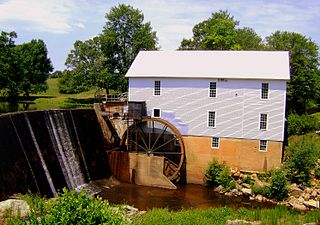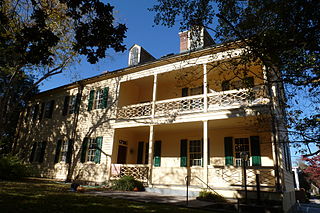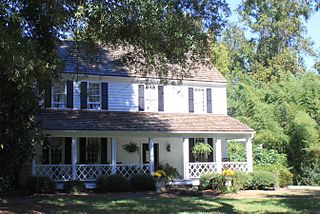
Thomas Bragg was an American politician and lawyer who served as the 34th Governor of the U.S. state of North Carolina from 1855 through 1859. During the Civil War, he served in the Confederate States Cabinet. He was the older brother of General Braxton Bragg. They were direct descendants of Thomas Bragg (1579–1665) who was born in England and settled in the Virginia Colony.

William Alexander Graham was a United States Senator from North Carolina from 1840 to 1843, a Senator later in the Confederate States Senate from 1864 to 1865, the 30th Governor of North Carolina from 1845 to 1849 and U.S. Secretary of the Navy from 1850 to 1852, under President Millard Fillmore. He was the Whig Party nominee for vice-president in 1852 on a ticket with General Winfield Scott.
Samuel Ashe was the ninth Governor of the U.S. state of North Carolina from 1795 to 1798. He was also one of the first three judges of the North Carolina Superior Court in 1787.

Bedford Brown was a Democratic United States Senator from the State of North Carolina between 1829 and 1840.

The North Carolina State Capitol is the former seat of the legislature of the U.S. state of North Carolina which housed all of the state's government until 1888. The Supreme Court and State Library moved into a separate building in 1888, and the General Assembly moved into the State Legislative Building in 1963. Today, the governor and their immediate staff occupy offices on the first floor of the Capitol.

Bentonville Battlefield is a North Carolina state historic site at 5466 Harper House Road in Johnston County, North Carolina. It belongs to the North Carolina Department of Natural and Cultural Resources and is the site of the 1865 Battle of Bentonville, fought in the waning days of the American Civil War. It was declared a National Historic Landmark in 1996.

Edenton Historic District is a national historic district located at Edenton, Chowan County, North Carolina. The district encompasses 342 contributing buildings, 4 contributing sites, and 3 contributing structures. It includes several buildings that are individually listed on the National Register. The Lane House, possibly the oldest surviving house in North Carolina, is owned by Steve and Linda Lane and is located within the district. Also located in the district are the Dixon-Powell House, William Leary House, and Louis Ziegler House designed by architect George Franklin Barber.
William Augustus Edwards, also known as William A. Edwards was an Atlanta-based American architect renowned for the educational buildings, courthouses and other public and private buildings that he designed in Florida, Georgia and his native South Carolina. More than 25 of his works have been listed on the National Register of Historic Places.

Elliott Daingerfield (1859–1932) was an American artist who lived and worked in North Carolina. He is considered one of North Carolina's most prolific artists.

Prospect House is a historic building, located at 3508 Prospect Street, Northwest, Washington, D.C., in the Georgetown neighborhood.

The House in the Horseshoe, also known as the Alston House, is a historic house in Glendon, North Carolina in Moore County, and a historic site managed by the North Carolina Department of Natural and Cultural Resources' Historic Sites division. The home, built in 1772 by Philip Alston, was the site of a battle between loyalists under the command of David Fanning and patriot militiamen under Alston's command on either July 29 or August 5, 1781. The battle ended with Alston's surrender to Fanning, in which Alston's wife negotiated the terms with the loyalists.

Halifax Historic District is a national historic district located at Halifax, Halifax County, North Carolina, US that was listed on the National Register of Historic Places in 1970 with an increase in 2011. It includes several buildings that are individually listed on the National Register. Halifax was the site of the signing of the Halifax Resolves on April 12, 1776, a set of resolutions of the North Carolina Provincial Congress which led to the United States Declaration of Independence gaining the support of North Carolina's delegates to the Second Continental Congress in that year.

Poplar Grove Plantation is a peanut plantation by the Topsail sound in Scotts Hill near Wilmington in Pender County, North Carolina. It was listed on the National Register of Historic Places listings in North Carolina on July 16, 1979.

Murray's Mill Historic District is a national historic district located near Catawba, Catawba County, North Carolina. The district encompasses 20+ contributing buildings near the rural Town of Catawba. It contains the mill buildings, four residences and complementing structures associated with the milling operations and the Murray family. They were built between the 1880s and mid-20th century. Notable buildings include the large two-story frame mill (1912-1913), store building, wheathouse (1880s), John L. Murray House (1913), a large gable roof frame barn (1930s), Lloyd Murray House (1935), and William Murray House (1880s).

Strawberry Hill is a historic plantation house located in Edenton, North Carolina, and owned by William and Laurie Raucci. The original section was built about 1788 in a Georgian/Federal style then enlarged to its present size in the early- to mid-19th century. It is a two-story, frame dwelling with a center hall plan. The front facade features a two-tiered, full-length porch. The original portion of the house was built by Congressman Charles Johnson.

Coor-Gaston House, also known as the Judge William Gaston House, is a historic home located at New Bern, Craven County, North Carolina. It was built in 1774, as determined by dendrochronology, and is a 2 1/2-story, "L"-plan, Georgian style frame dwelling with a gable roof. It features a two-tier porch enclosed by Chinese trellis railings and supported by Doric order pillars. It was the home of Congressman and jurist William Gaston (1778-1844).

For the Beaver Dam Plantation in Tennessee, see Beaver Dam Plantation.

Pleasant Hill, also known as Rivenoak and Hawkins House, is a historic plantation house located near Middleburg, Vance County, North Carolina. It was built in 1759 and remodeled in the 1850s in the Greek Revival style. It is a 2 1/2-story, five bay, Georgian double pile plan frame dwelling. It has a moderately steep gable roof with dormers and double-shoulder brick chimneys. The original dwelling was probably built by Philemon Hawkins, Jr., and birthplace of Governor William Hawkins (1777-1819).




















